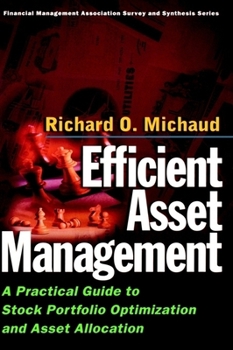Efficient Asset Management: A Practical Guide to Stock Portfolio Optimization and Asset Allocation
Select Format
Select Condition 
Book Overview
The failure of optimized portfolios to meet their practical investment goals has prompted many portfolio managers to abandon optimization techniques for simpler alternatives to maximize asset value. Yet, according to financial expert Richard Michaud, readily available methods exist to help practitioners reduce instability and enhance the value of optimization--tools that the investment community has largely ignored. In his succinct new book, Michaud argues that the problems lies with the conventional perception of optimization as a numerical computation; this view has severely restricted the typical manager's understanding of inherent limitations--and resulted in optimized portfolios that frequently fall short of their potential. If, instead, managers approach optimization as a statistical estimation, Michaud argues, they can resolve many of the serious limitations. Michaud identifies and explains five powerful techniques--improved estimation, application of benchmark priors, integration of active forecasts, tests for efficiency, and tests for portfolio weights--that portfolio managers can use to reduce errors, increase precision, and enhance the value of seemingly optimized portfolios. He illustrates the impact of each method with a simple asset allocation problem. With its important implications for investment practice, Efficient Asset Management 's highly intuitive yet rigorous approach to defining optimal portfolios will appeal to investment management executives, consultants, brokers, and anyone seeking to stay abreast of current investment technology. Through practical examples and illustrations, Michaud updates the practice of optimization for modern investment management.
Format:Hardcover
Language:English
ISBN:0875847439
ISBN13:9780875847436
Release Date:June 1998
Publisher:Oxford University Press, USA
Length:152 Pages
Weight:1.00 lbs.
Dimensions:0.7" x 9.2" x 5.9"
Customer Reviews
5 ratings
Important information when considering Markowitz optimization
Published by Thriftbooks.com User , 17 years ago
Michaud's resampling methodology is quite rigorous, although the patentability of application of econometric concepts that are over 40 years old to a theory advanced by Markowitz in 1952 should be seriously questioned by any rational reader. The applicability of resampling and improvements to the inputs to estimation are clear, and should be strongly considered by anyone in the asset management industry. The book glosses over other approaches to optimization that are not based on Markowitz, all but ignoring the huge body of literature that has been built up around other optimization approaches. Except for this shortfall, this is an excellent book, and shoulds be a part of your library on quantitative asset management.
Required Reading for Sophisticated Investors
Published by Thriftbooks.com User , 19 years ago
This is an excellent book for the readers with solid quant skills. This is not a course in investing for poets. So be honest with yourself about your capabilities and needs.
Raises important questions
Published by Thriftbooks.com User , 23 years ago
Michaud raises several important issues that one is sure to encounter in portfolio optimization. Michaud exposes the fallibility of mean-variance optimization and suggests several techniques to obtain more reliable results. His conclusions merit consideration. Props for increasing the breadth of statistical scope of efficient asset management. Michaud is also a fluid writer. My largest complaint is that the majority of his work utilizes sign-constrained (long-only) optimization. If you manage, advise or consult on portfolio management and you utilize optimization techniques or have considered them, you should become knowledgeable with the contents of this book.
Raises important questions
Published by Thriftbooks.com User , 23 years ago
Michaud raises several important issues that one is sure to encounter in portfolio optimization. Michaud exposes the fallibility of mean-variance optimization and suggests several techniques to obtain more reliable results. His conclusions merit consideration. Props for increasing the breadth of statistical scope of efficient asset management. Michaud is also a fluid writer. My largest complaint is that the majority of his work utilizes sign-constrained (long-only) optimization. If you manage, advise or consult on portfolio management and you utilize optimization techniques or have considered them, you should become knowledgeable with the contents of this book...
all you ever wanted to know...
Published by Thriftbooks.com User , 23 years ago
This short, simple book offers a synthesis of research about the uses and practical problems associated with Markowitz optimization procedures. It will give you a good opportunity to see in a few interesting hours what can go wrong in implementing MV optimization and what to do to improve the process. Things that are relatively obscure, but have a direct practical relevance, such as considering the efficient frontier as having a variance, and offering some pointers on where to get arcane Stein-like estimators for the variances and covariances (Ledoit estimators). There is no math entrance barrier (almost no equations), so this book will be of benefit to users of MV optimization who want to understand the issues deeper and not just press on a button and assume that the weights they get make sense. It is to be noticed that this is not the book for those interested in quadratic programming algorithms per se, as the focus is more from a user point of view. Also notice there are no new results in the book and that sometimes I wished some discussions were more detailed - but they may be too detailed for some other readers as well. In brief an honest book, not too dumb and not too hard. An interesting and useful reading for all users of MV optimization. Also, a perfect book to complement an undergrad education in finance. NOTE: Although the presentation, printing and binding is similar to the infamous NYSE "technical" books or Wiley trader's advantage series, this is actually a good vulgarization book written by somebody having an academic training. No chaos, technical analysis or other arbitrary opinions are to be found here. In case you'd be scared by the look of it...






